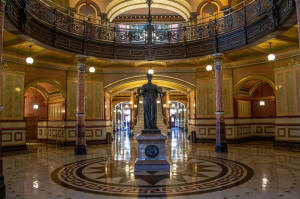Statue task force considers adding, removing state monuments
 Send a link to a friend
Send a link to a friend
[May 20, 2021]
By SARAH MANSUR
Capitol News Illinois
smansur@capitolnewsillinois.com
 SPRINGFIELD — A state House task force
continued its discussion about reevaluating controversial statues and
whether new monuments commemorating minorities should be added to the
state Capitol grounds. SPRINGFIELD — A state House task force
continued its discussion about reevaluating controversial statues and
whether new monuments commemorating minorities should be added to the
state Capitol grounds.
The hearing Wednesday is the second meeting of the bipartisan Statue and
Monument Review Task Force, which was formed by Speaker Emanuel “Chris”
Welch last month. The purpose of the task force is to conduct a review
of monuments on state property and proposals for new monuments or
statues.
Adam Green, an associate history professor at the University of Chicago,
was one of four speakers who shared their perspectives on the task
force’s charge.

Green said statues, monuments and memorials and the naming practices for
buildings, parks, streets and other components of the built environment
play a crucial role in defining communities.
“They establish a heritage that gives our shared community a sense of
origins, continuity and endurance, they signal which individuals and
what actions or contributions are worthy of honoring or even emulating,”
Green said. “They also identify implicitly, and sometimes quite
explicitly, those values that are understood to be ones which the
residents of the state and visitors to the state can consider aspiring
to live by.”
Katherine Poole-Jones, associate art history professor at Southern
Illinois University at Edwardsville, said the task force must ask what
values they wish to collectively endorse in the public realm.
“We look at each monument, (and ask) is it representative of those
shared community values and ideas, if it ever was?” Poole-Jones said.
“Because that's also a possibility, that it never was. What is the value
of the monument remaining in public space? How is the community
benefiting from the monument?”
“And I think we also have to carefully balance that against the
discomfort, the pain, the alienation, it may cause some members of the
community, because we have to understand that the spaces that monuments
occupy cannot be entered into in a neutral way for everyone,” she added.
She said this is especially crucial to think about when discussing the
grounds of government buildings, “because, of course, the history of
Confederate monuments was putting them up at statehouses as tools of
intimidation.”
The city of Chicago is undertaking a similar examination of its statues,
and two Chicago monuments of Christopher Columbus were temporarily
removed last summer as part of this effort.
Some cities, including Richmond, Va., Jacksonville, Fla., and
Indianapolis, Ind., have removed statues of Confederate officers.
Last year, former House Speaker Michael Madigan requested that the board
of the Office of the Architect of the Capitol remove monuments of
Stephen Douglas and Pierre Menard from Capitol grounds.
Douglas, a slave owner, served as Illinois’ secretary of state, state
Supreme Court justice and in the U.S. Senate among other roles.
Menard, also a slave owner, was the first lieutenant governor of
Illinois, and he supported political actions devised to ensure slavery
was legal in the state.
[to top of second column]
|

The Illinois State Capitol rotunda is pictured in
Springfield. (Capitol News Illinois file photo)
\
Rep. Mary Flowers, a Chicago Democrat who chairs the
committee, suggested the task force consider adding monuments
commemorating former President Barack Obama, as well as Harold
Washington, Chicago’s first black mayor; Ida B. Wells, a co-founder
of the NAACP; and Rudy Lozano, a labor activist from Chicago’s
Little Village neighborhood.
But Rachel Leibowitz, an assistant professor at the State University
of New York, cautioned the task force against adding too many new
figurative monuments and memorials to the Capitol grounds.
She pointed to the Texas Capitol grounds, which has 22 statues,
monuments or memorials.
“And, their site is physically larger than yours with the Stratton
building, so this is just to say there can be a lot of physical
clutter on the ground,” she said.
Leibowitz said the committee could also consider relocating statues
or monuments from the Capitol grounds to another place, like a hall
of statues.
“I suggest that only because then the state capitol grounds becomes
open to everyone,” Leibowitz said. “There is no one there saying, ‘I
am not represented.’ There is no one saying, ‘I don't see myself and
my story reflected.’ It is the building, it is the ground. It's
something to consider. I'm not saying that's the solution, but I
just want to offer that as a possibility.”
She also raised the possibility of constructing abstract memorials,
such as the Vietnam Memorial in the Washington, D.C.

“I would encourage you also to consider as you move forward…is what
you want more figurative statues, more great men or great women on
pedestals, or do you want to create something that is more
inviting?” she said. “Do you want to celebrate, for example, the
life of Dr. King in a way that offers moments in time, that shows
struggles and triumphs? How do you want to commemorate this history
moving forward? You have options.”
Flowers and Republican spokesperson Rep. Tim Butler, of Springfield,
have endorsed relocating and redesigning the statue of Martin Luther
King Jr. that is currently placed across the street from the Capitol
grounds.
Secretary of State Jesse White, who also supports this proposal, has
pledged $5,000 towards the construction of a new King statue.
Flowers said White and the Architect of the Capitol Andrea Aggertt
will present at the next task force meeting, which has not yet been
scheduled.
Capitol News Illinois is a nonprofit, nonpartisan
news service covering state government and distributed to more than
400 newspapers statewide. It is funded primarily by the Illinois
Press Foundation and the Robert R. McCormick Foundation. |